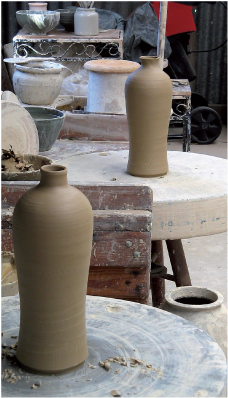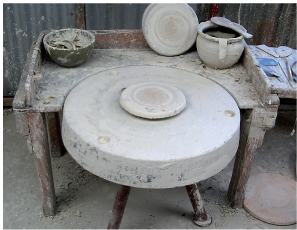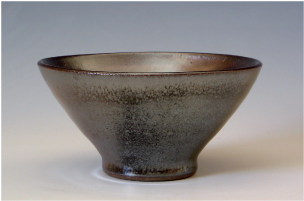Appearing under the banner ‘Scotland’s Last Ceramics Course to Close’, the March 2008 article from the Glasgow Sunday Herald discussed the imminent demise of ceramics at the Glasgow School of Art. Responding to concerns raised by current students, ex-students and staff – one of whom was the potter Alex Leckie, an influential figure who worked in South Australia as far back as the late 1950s – the article quoted a statement released by the school, which reads as follows.
‘Across our other design programmes, competition for places is very high. In contrast, a growing lack of competition for places within ceramic design represents a significant risk to Glasgow School of Arts academic reputation and makes it difficult to ensure that consistency of student attainment is maintained across the design programme.’

I do think the phrase ‘significant risk’ is worth highlighting, as we all know just how dangerous ceramics can be.
This press-release mirrored, albeit rather bluntly, a conversation I had recently with the Dean of an Australian art school, one of a diminishing number where ceramics is still offered as part of the syllabus. The phrase this person used concerning the future of ceramics was, and I quote: ‘Between you and me, mate, it’s buggered’, a comment which at least dispensed with the management-speak emanating from the GSA.
Ceramics, it seems, is well on its way to becoming a historical oddity, a phenomenon which had taken off in the post-war era and would fizzle out in the early twenty-first century, only to be remembered as a minor curiosity of Australian art history. Some even thought they could pinpoint the time when Australian ceramics began its decline. Apparently it occurred at a meeting of the Australia Council in the early 1990s when the crafts were amalgamated with the visual arts for funding purposes, resulting in the creation of the dreaded level playing field.
This view sheets home any current difficulties to a time when ceramics began to be treated in the same way as the rest of the visual arts, something which, in all fairness, many ceramists had wanted for years. I take another view, in attributing the current malaise to the fact that ceramics had already started to mimic the rest of the visual arts, in the mistaken belief that the rich, complex and often puzzling world of contemporary art somehow lacked enough things made out of clay. In doing so, it neglected to value its own craft traditions, while at the same time it largely failed to assume the critical rigor that would validate its participation in the fine arts.

This mostly came about because ceramics, for quite some time now, has been solely taught within an art school system transfixed by the razzamatazz of contemporary art, an enterprise so successful at marketing, public relations and branding, that what is being presented hardly matters. The money that is thrown at contemporary art is quite staggering, and I would guess that the budget for Australian representation at the Venice Biennale alone overshadows any federal funding for the crafts. Only today — as I was putting the finishing touches on a wood-kiln, of all things — I was stunned to learn that a tabloid newspaper in Adelaide had opined that what the city really needed was a Guggenheim! I’m guessing that this wasn’t because the editors were desperate to see more contemporary art, but simply that they had heard about the brand. I doubt that suggestions of building a small annexe to house the Art Gallery of South Australia’s wonderful collection of Thai and Cambodian ceramics would be met with such journalistic enthusiasm.
Yet, given the primacy of contemporary art within the education system and its overwhelming presence in the cultural landscape, it is no wonder that some ceramics departments began taking on some of the more dubious benefits of a theory-laden environment which had become part and parcel of art school education.
Earnest discussions took place about Gaston Bachelard, who had written a book called The Poetics of Fire– perhaps it was mistaken for a book on kilns? Julia Kristeva was abject and Jacques Derrida was everywhere, causing otherwise perfectly normal people to look po-faced and babble about the concept of difference in a silly French accent. In a bid to reign in the confusion, a leading art school paid a philosopher (as opposed to a hack art theorist) to come down from Melbourne Uni one morning and answer questions from the student body. I still remember seeing a hand being raised during question time and hearing a small voice ask, ‘Please, can you tell me what hermeneutics are?’, sounding for all the world like the urchin Oliver asking for more food in the poorhouse.

In an unfortunate coincidence, the uncertainties of post-modernism coincided with a series of amalgamations in higher education, implemented in a policy called the Unified National System thought up by John Dawkins, Hawke’s education minister from 1987 to 1990. Doing away with CAEs, Teachers Training Colleges and the like, this collection of new and expanded universities were soon to be subjected to the strictures of economic rationalism, first with Keating and then increasingly under the Howard regime. At a time when universities were forced to offer a plethora of courses in management and business studies to fee-paying students just to stay afloat, it is quite obvious that the humanities, and particularly the arts, would suffer. (In fact, one could also say the same things about the sciences. I was in the geology department of a major university the other week where basic analytical equipment was not maintained in working order and there was no longer a technician, which, given the importance of minerals and mining to the Australian economy, is a bit of a worry.) That these financial strictures never seem to affect the budget for new buildings is one of life’s great mysteries.
Still, it is hard to think of any course that is more vulnerable within a financially stretched, economically-rationalised university than a course in ceramics. And, quite frankly, it is hard to think of any course that is more ill-suited to being taught within a university.
Luckily, and perhaps inevitably, the decision of how to reconcile these glaring contradictions seems to have been taken out of the hands of most art school ceramics departments within universities, due to the simple fact that they are closing down.
The reality is that there are now very few art schools – or TAFES for that matter – offering any training in ceramics at all. The ‘elephant in the room’ of Australian ceramics education in 2008 is that of the art schools which do still offer ceramics, only a few are able to do their job properly, due to the severe cutbacks in staff and equipment which have plagued them for years.
Again, let me stress that there still are some places where the training is of a good standard – I won’t single them out but it’s pretty obvious where they are – but they are precious few and diminishing as we speak. So, the question is, what are we to do about all of this?
For a start, I’d give up on the idea of a large scale reinvigoration of ceramics within the art school system. It’s not going to happen, and I’m not sure it should even if it could. Most art schools never really considered ceramics as part of their ‘core business’ anyway and to hang around when it is obvious one is not wanted is undignified. But there are alternatives approaches that might be taken, and one of them is as follows.
Someone who wants to learn how to make pottery should be able to work with a skilled, mature practitioner in a thorough, ongoing, comprehensive fashion in a workshop-based environment.
I am not talking about the current system of mentoring here, in that mentoring normally involves taking someone who already has decided on a form of individual expression and then pairing them with an experienced practitioner who gives sage but occasional advice, although this doubtless has its benefits. What I am talking about is a system where a student enters a workshop and is trained in the style and philosophy of the teacher. In six months a student could easily learn more workshop skills in this way than in three years in an art school ceramics department.
Of course, their experiences would largely be shaped by the type of work made by the teacher, but surely a student would choose a teacher because they liked their style of work in the first place? Perhaps this might be called a traineeship mentorship as opposed to emerging (and don’t we all love that term?) mentorship. Instead of looking at mentoring as an activity that occurs towards the end of an art school education, maybe a traineeship mentoring scheme would be valuable as a precursor to art school, at least ensuring that the student goes into further education with some basic skills.
Whether a student was interested in wood-firing, funky sculptural work or slick and reductive porcelain, the main repository of expertise and knowledge — as opposed to information — rests, quite literally, in the hands of experienced makers, most of whom do not work in art schools. This is a resource that is going begging, as far as education is concerned.
As someone who has numerous degrees, including a doctorate in art history, I am very aware of the significant role an academic training in the arts plays in educating, informing and challenging one’s views.
Equally, I can say without doubt that my grounding in actually making pottery was gained through working with my father — one of this countries most respected potters and someone who doesn’t have a degree to his name – and in time spent working in production potteries, in travelling and visiting museums, in meeting with other potters and simply by looking at and handling pots in the company of others who also knew and cared about pottery. This is the way many people used to learn. It is the way Gwyn Hanssen Pigott learned as did her teacher, Ivan McMeekin and it makes a good deal of sense.
In conclusion, I do not advocate the wholesale scrapping of art school ceramics training. Institutions like the Jam Factory in Adelaide and Sturt Workshops in New South Wales also play an important part, as do the plethora of associations, collectives and clubs around the country. I do want to see a healthy diversity in educational options and workshop based training should play an increasingly important role in the future.
And no, I don’t know how this is to be achieved. Maybe students should think about other ways that a $5,000 a year HECS debt could be made to work for them, or if the Austudy payment of approximately $175 per week, with all its entanglements in the bureaucracy of Centrelink, is the deciding factor as to whether one studies at an art school or comes to a private arrangement with a teacher. Maybe a teacher should consider just how much they would want for their services?
All I can say is that I would consider very seriously any requests that came my way.
Damon Moon
Willunga, 2008